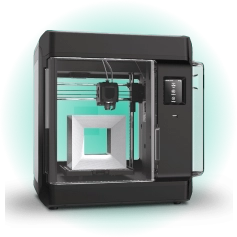Time to read: 8 min
Is prototype injection molding an oxymoron? If you’re like most designers, you’ve learned that plastic injection molding is for high volumes of production-quality (i.e., non-prototype) parts. Maybe you’ve also heard that steel injection molds are for higher volumes, aluminum injection molds are for lower volumes, and that both types of molds are too expensive for prototypes.
If any of this sounds familiar, it’s time to unlearn some of what you’ve been told and to re-think your prototyping and production options. Yes, plastic injection molding is a high-volume production process. Yet there are also times to use it for prototyping – and for low-volume production as well. As for injection molds, there’s more to consider than just aluminum vs. steel.
Do prototype injection molds come at a cost? Yes, but there are ways to reduce your expenses, as this article will explain. Do injection molds take a long time to produce? If you expect mold-making to take several months, you’ll be pleasantly surprised to learn that the right manufacturing partner can produce tooling in just a few weeks. Take a look at the big picture and consider your part design and material selection along with tooling costs and machining times. And remember that help is available when you share your part design with Fictiv. For example, if your design doesn’t contain enough draft, our DFM experts will suggest a larger draft angle so that your parts eject smoothly.
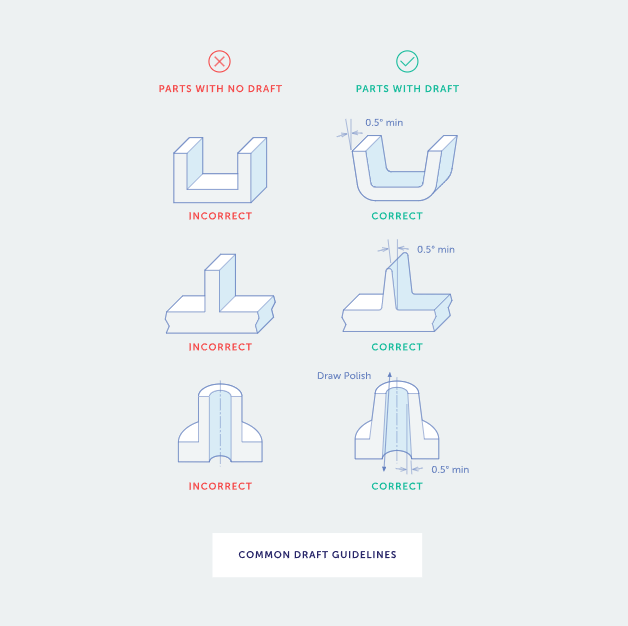
Fictiv’s Injection Molding Design Guide contains advice about draft angles for prototype injection molding. This free resource is available for download.
Part Design and Prototype Injection Molding
How mature is your part design? If you’re not ready for manufacturing, you’re probably still in the prototyping stage. But which type of prototype do you need?
- Proof-of-concept prototypes let you evaluate scale, form, and maybe some basic functions.
- Looks-like prototypes let you visualize the product’s final appearance.
- Works-like prototypes let you validate form, fit, and function.
- Pre-production prototypes let you validate both the product’s final appearance and its utility.
This isn’t the only way to categorize prototypes, but the above list provides a framework for what follows.
3D Printed Prototypes vs. Injection-Molded Prototypes
Most proof-of-concept prototypes and looks-like prototypes don’t warrant the cost of an injection-molding tool. That’s because the designer usually needs just one or two parts, and it’s difficult to justify the expense of an injection mold when you’re spreading the total tooling cost across just a few parts.
Works-like prototypes and pre-production prototypes are a different story. Often, a designer needs part volumes that are measured in tens rather than in single digits. Depending on the quantity then, it might make sense to use injection molding instead of 3D printing, which does not require tooling but is not the intended production process.
Consider the difference between molding one proof-of-concept prototype vs. 100 pre-production prototypes. In both instances, let’s say the cost of the tool is $10,000. For one proof-of-concept prototype, the per-part tooling cost is $10,000. For 100 pre-production prototypes, the per-part tooling cost is $100. That’s a big difference.
The table below explains what to consider when comparing 3D printing vs. injection molding for prototyping.
| Parameter | 3D Printed Prototypes | Injection-Molding Prototypes |
| Design State | Evolving designs that are still in the concept stages | Finished designs that need real-world testing |
| Production Quantities | Very low quantity requirements | Prototype quantities that exceed 100 pieces |
| Lead Times | Lead times of 1 to 15 days | Leads times of 2 to 5 weeks |
Now think about design for manufacturability (DFM), the process of designing parts in such a way that they’re easy to manufacture. Let’s say you 3D-print some components that you then assemble. They fit together flawlessly and let you test the product’s functionality.
That’s great, but what if injection molding these same parts results in production failure? How can that happen? Your 3D-printed prototypes might be perfect but don’t assume that level of perfection will translate seamlessly into the perfect injection molded part.
Design Rules, Part Features, and Tolerances
3D printing has different design rules, such as minimum wall thickness, than injection molding. That’s important to remember because walls that are too thick, too thin, or non-uniform are a frequent cause of failure in production injection molding. The best way to avoid this problem is to use prototype injection molding to create parts that let you identify any production challenges.
There’s more to consider as well. The file formats for 3D printing and plastic injection molding are different. Specifically, the STL files that are used in 3D printing define objects in terms of a triangle mesh. By contrast, the CAD files that contain the designs for injection molded parts are parameter-driven.To use your 3D printing files with injection molding, you’ll need to convert them from a mesh to a shape to a solid.
3D printing and injection molding also have different tolerances, or allowable part-to-part variations. In most additive manufacturing technologies, the dimensional tolerance is at least 0.1 mm. Therefore, the deviations in 3D printing are greater than with injection molding. Plus, injection molding has two types of tolerances: commercial and fine.
Ready for some good news? Fictiv provides expert DFM assistance through 3D visualization for injection molded part design. There’s also this handy online checklist so that you can determine if you’re ready to go from 3D printing to injection molding. And remember that you don’t have to wait until your parts are production-ready to get injection-molded samples.
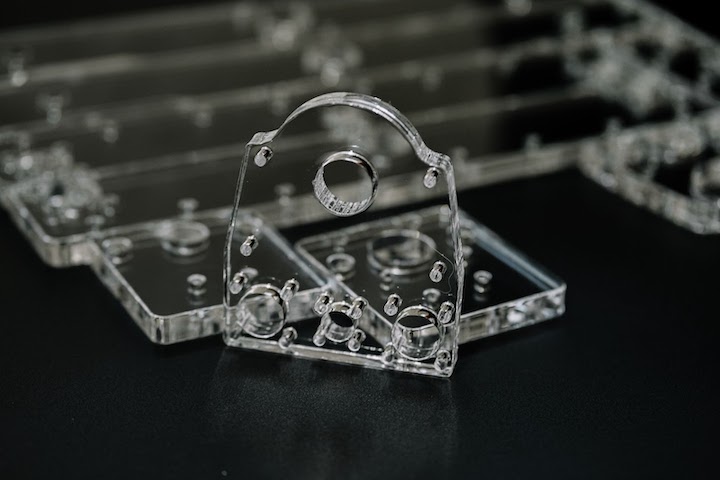
Acrylic is a commodity plastic that can be used for injection-molded prototypes
Material Selection and Prototype Injection Molding
Prototype injection molding and production injection molding can both use the same plastics. However, abrasive materials such as glass-filled nylon will cause prototype injection molds to wear more quickly. (That’s because prototype molds are usually made from softer materials.) Still, if you’re planning to prototype 100 parts, wear is less of an issue than it would be with a full-scale production run of 10,000 parts.
Commodity Plastics vs. Engineering Plastics
If your part design is still in its early stages, you might decide to use commodity plastics that are less expensive, even if they don’t have the same mechanical properties as your intended production materials. For example, PEEK is an engineering plastic that’s used in some medical devices. It costs significantly more than other polymers and may have a high minimum order quantity (MOQ) if your supplier doesn’t buy it in large enough volumes to receive a discount.
For a works-like prototype, you could use a less expensive material like polyphenylsulfone (PPSU). In fact, PPSU might be a fine choice. Yet using anything other than PEEK won’t provide a full test of your part’s moldability. Since PPSU and PEEK are both available as 3D-printing filaments, could you use additive manufacturing instead? You’d save on tooling costs, and you could use the plastic that you want. Sounds simple, right?
All Part Samples Aren’t the Same
That approach might not provide what you need. 3D-printed materials don’t have the same end-use properties as their injection-molded counterparts. For example, 3D-printed PEEK isn’t as strong as injection-molded PEEK. And if your part is for a medical device, you’ll need representative samples for the first article inspection (FAI). The best way to get them is to use the same material and the same process as you plan to use for full-scale production. That’s injection molding.
If you upload your part design to Fictiv, you can ask our DFM experts for more information.
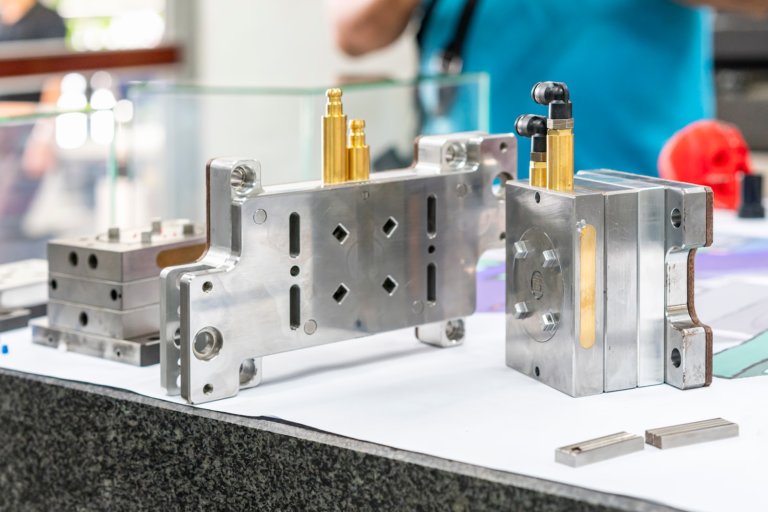
Prototype Injection Molds: Beyond Steel vs. Aluminum
What’s the difference between a prototype injection mold and a production injection mold? It’s not about the metal that the mold is made from. Production molds can be made from aluminum or steel and prototype molds can be made from aluminum or steel. And it doesn’t end there. There are several different steels that are used in injection molds – and there isn’t just one kind of aluminum.
SPI Classes and Prototype Parts
There are also SPI classes for mold finish to consider. In the table below, look at SPI Class 105. That’s the one for prototype quantities.
| SPI Mold Class | Volume | Cycles |
| 101 | High | Over 1 million |
| 102 | Medium-to-High | 500,000 to 1 million |
| 103 | Medium | Under 500,000 |
| 104 | Low | Less than 100,000 |
| 105 | Prototype | Less than 500 |
What about the other SPI mold classes? Ideally, a production injection mold is designed and built for the fastest cycle times, the highest quality parts, and the longest tooling life (i.e., cycles). For prototype injection molds, long tool life is less important than part quality, especially for a few FAIs (first article inspections). Cycle time is also less important, at least if your goal in prototyping is to produce, say, 100 representative pre-production prototype parts.
Aluminum vs. Soft and Semi-Hardened Steel vs. Hardened Steel Molds
Yes, the metal that your mold is made of plays an important role in all of this. But you have more choices than just aluminum vs. steel. Specifically, you can choose:
- Aluminum in different grades
- Soft and semi-hardened steel in different grades
- Hardened steel in different grades
Aluminum is your least expensive choice, but it won’t produce injection-molded parts with tolerances that are as tight, or precise, as those with steel molds. That’s an issue if tight tolerances are required, but it can also affect tolerance stack-ups in assemblies with several injection molded parts. Aluminum injection molds can be machined to tolerances of +/- 0.005 inches, but steel molds can be machined to tolerances as tight as +/-0.001 inches.
Soft and semi-hardened steels typically cost twice as much as aluminum but don’t rule them out for prototype injection molds. These steels can achieve tighter tolerances and aren’t so difficult to machine that it takes months to cut a tool. When you work with Fictiv, you can get prototype steel molds in as little as 10 to 14 days.
Generally, hardened steel is used with production injection molds. It’s more expensive than soft or semi-hardened steels, but hardened steel lasts longer (i.e., more cycles) and can achieve tighter tolerances. Prototyping doesn’t have to produce millions of parts, of course, but what if you need tight tolerances for medical, aerospace, or other demanding applications? Aluminum just won’t do.
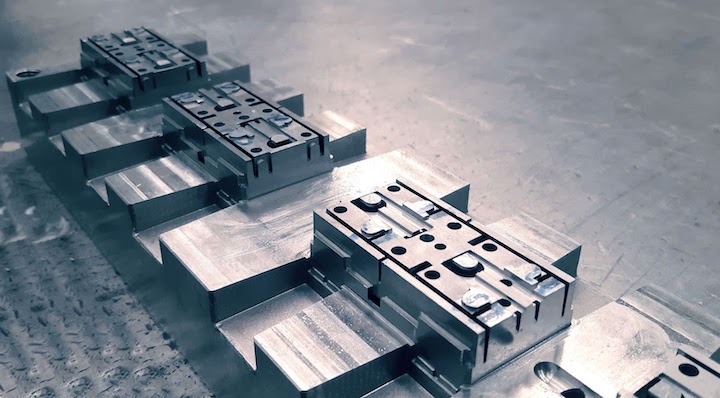
Multiple Mold Materials and MUD Dies
Fortunately, injection molding supports the use of multiple mold materials. For example, the base of a prototype mold could be made of aluminum or soft or semi-hardened steel. The inserts could then be made of soft, semi-hardened, or hardened steel. If your mold requires moving components such as lifters, those components could be made of steel as well.
There are also master unit die (MUD) inserts with a standard mold frame and customized, removable inserts. MUD molds, as they are called, can lower the cost of initial tooling by as much as 66%. Yet they still support the complexity that many designers need for prototyping. If you need to modify your design, as is often the case with prototypes, a toolmaker can modify just the insert.
Finally, prototype injection molding ensures that your mold uses the right gate type and location so that the mold cavity fills evenly and the plastic is held under pressure long enough to produce parts with consistent quality. An injection molder can use mold-flow-analysis software instead, but that won’t put a part in your hands now, will it?
Ask Fictiv About Prototype Injection Molding
Fictiv operates a global network of highly-vetted and managed manufacturing partners for injection molding s and can help you take your product from prototyping through production. Because we offer a wide range of capabilities through a single platform, including both 3D printing and injection molding, you can use the process that you need when you need it. You won’t find that type of one-stop shopping everywhere, and we can produce complex parts (including prototypes) at blazing speeds.
Ready to get started? Create a Fictiv account and upload your part design.








